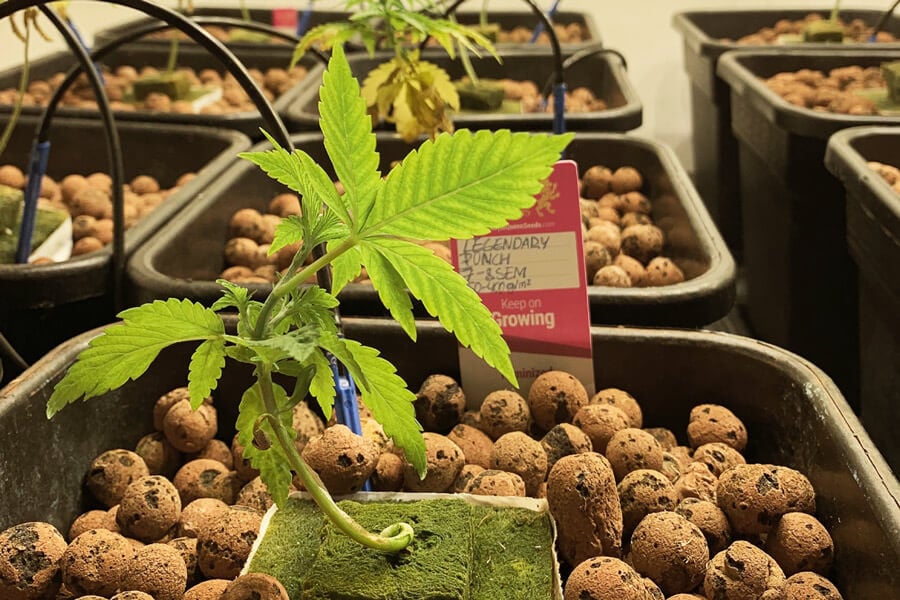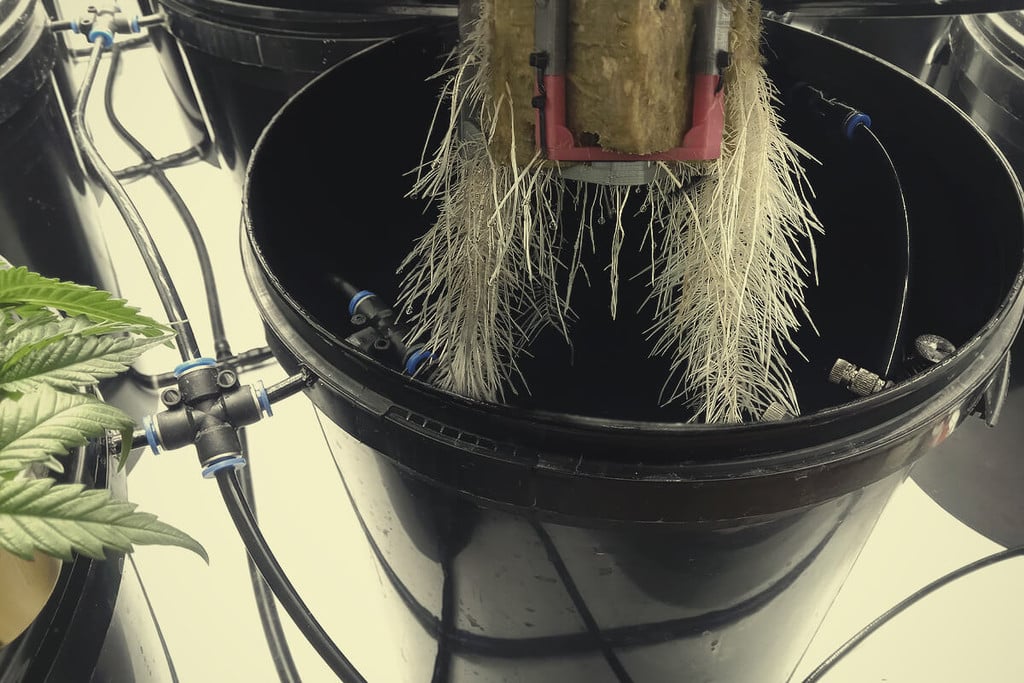.
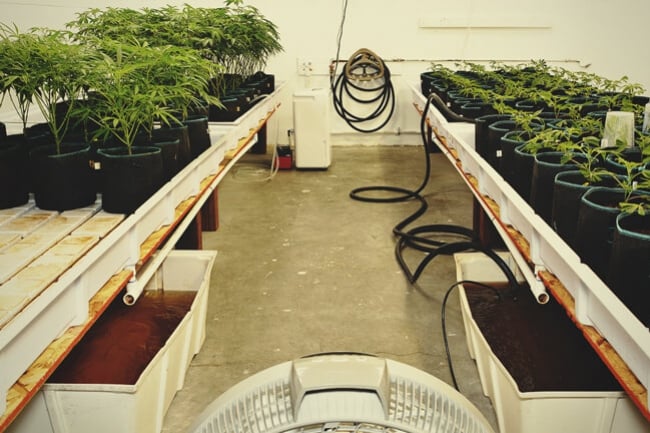
The Benefits of Nutrient Film Technique for Growing Cannabis
There are a host of hydroponic systems to chose from, but nutrient film techniques offers something truly unique. This system maintains a constant flow of shallow water across plant roots, forming a hydrating film around these important structures. It uses very little water compared to growing in soil, yet produces healthy plants in less time.
Contents:
There are a variety of ways to grow cannabis plants hydroponically. However, nutrient film technique stands out among the rest. This approach uses a water reservoir, airstone, pump, and growing channels to produce cannabis plants over a brief window of time. Experience better root development, fewer nutrient deficiencies, and modular systems that are scalable to any growing situation.
Nutrient Film Technique Definition
Nutrient film technique (NFT) maintains a coating—or film—around plant roots by constantly exposing them to a nutrient solution. NFT systems pump this solution from a reservoir into a series of long and narrow channels. Here, it forms a very shallow stream of water that trickles by plant root systems, providing them with a finely-formulated cocktail of nutrients that optimises plant growth, development, and productivity.
First discovered by Dr Allen Cooper in the 1960s, NFT has become a popular method in both home and commercial cannabis cultivation. Why? Because it’s generally much more effective than other techniques and comes with a host of advantages. These benefits include water and nutrient efficiency, minimal space requirements, low maintenance, and rapid growth rates.
How Nutrient Film Technique Works
Nutrient film technique systems are simple—very simple. The combination of a reservoir, pump, and slanted growing channels works to circulate the nutrient solutions past plant roots. To get to know all of the workings of NFT systems on a deeper level, check out all of the individual components below and their role in the system:
The Essential Components of Nutrient Film Technique Systems
- Reservoir
- This container holds the nutrient solution and varies in size depending on the number of plants present and the size of the system itself.
- Nutrients
- Hydroponic nutrient solutions contain all of the mineral salts that cannabis plants require to grow. These include the three macronutrients nitrogen, phosphorus, and potassium, and a suite of micronutrients including zinc, copper, and manganese.
- Airstone
- These devices pump air into the reservoir, increasing the dissolved oxygen content of the nutrient solution.
- Pump
- This piece of kit forces the oxygenated nutrient solution out of the reservoir and into the growing channels.
- Growing channels
- These long and narrow structures sit at an angle, enabling gravity to pull the stream downwards.
- Net pots
- Cannabis plants sit on top of each channel, kept secure by net pots that feature gaps to allow roots to grow down into the channel below.
- Return line
- Once the nutrient solution reaches the end of the growing channel, it flows through a return line and back into the reservoir to start the cycle again.
-01.jpg)
_%20%20%20.jpg)
How To Build Your Own Nutrient Film Hydroponics System
Now you’re aware of the different components of NFT systems, it’s time to make your own at home. Below, we’re going to tell you what you’ll need to build a simple setup. Don’t worry, if this feels too easy for you, you can simply scale things up. Then, we’ll walk you through how to put everything together, one step at a time.
What You’ll Need To Build Your NFT System
To build your own NFT system at home, you’ll need the following materials:
- 42.9 inches square gutter pipe
- Drill with hole saw
- Christmas tree drill bit
- Cable ties
- 3.9 inches net pots
- Pump
- 10-gallon plastic tote
- Airstone
- Heat gun
- Pliers
- Wood/PVC pipes/scaffolding
- Stanley knife or jigsaw
The length of the square gutter pipe used will depend on the number of plants you want to grow. Plants in 3.9 inches net pots will require 7.8 inches spacing. Therefore, taking the size of the net pot into account, you can grow three plants in a 42.9 inches stretch of gutter pipe. Feel free to use a longer or shorter section of pipe, depending on your preferences.

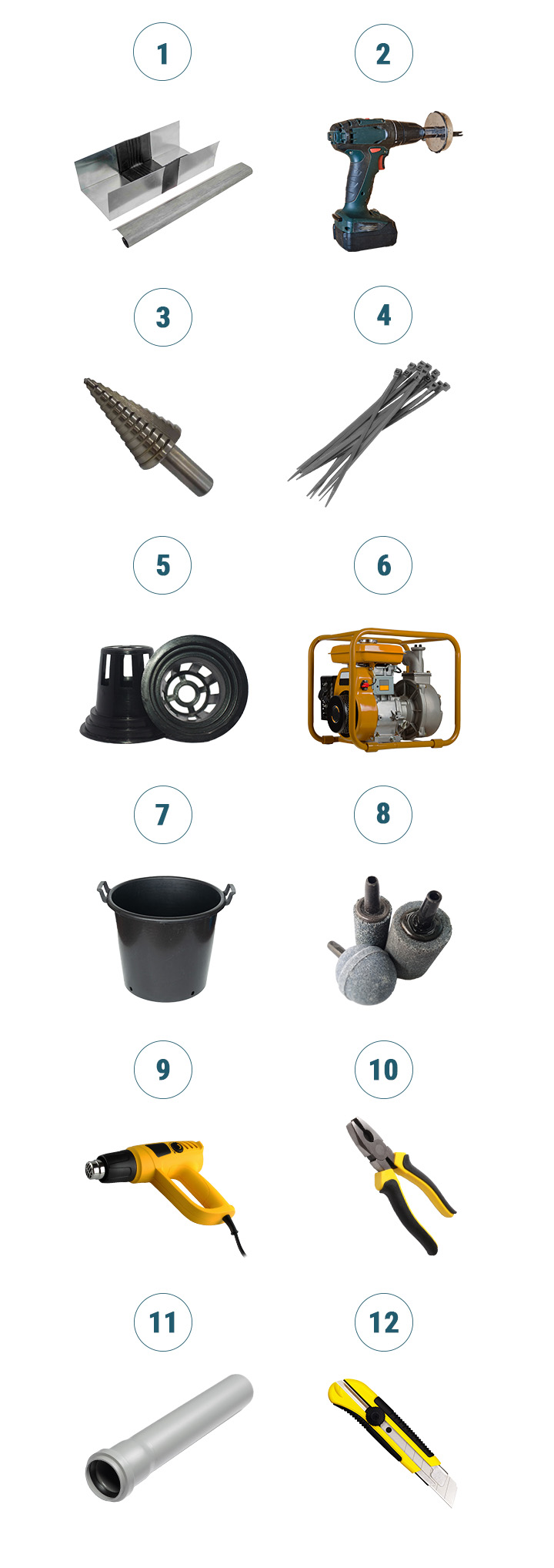
Build Your NFT System Step-By-Step
Now that you have everything you need, let’s get down to business! Follow the steps below and you’ll have yourself an operational system in no time.
Step 1: Build your frame
To kick things off, you need to build yourself a frame to hold your growing channels. You can use either wood, PVC pipes, or scaffolding to achieve this. The height of your frame depends on personal preference, whereas its length depends on the number of plants you want to grow in each channel. In this context, we suggest making a frame with a length of 50.7 inches to accommodate a 42.9 inches section of guttering. You’ll also need several centimetres of additional height on one end, to allow the channel to sit at an angle. Aim for a slope of around 3% to facilitate gentle flow while preventing pooling in the channel. Use cable ties to secure your channel to the frame.


Step 2: Prepare your channels
After constructing your frame to your own preference, you’ll need to prepare your growing channel. Before you start drilling, you’ll need to mold the end of your channel. Apply a heat gun to the top end until malleable. Close the end shut and angle it upwards to create a sealed lip to prevent water from leaking out of the top.
Now, let’s get those net pots in place! Use a tape measure and lay it along the middle of your 42.9 inches guttering. Place a mark at the 9.8 inches, 21.5 inches, and 33.2 inches points. This will create a spacing of 7.8 inches between each plant while taking the size of the net pot into account. Next, use your hole saw and aim the drill bit at each mark to create three holes with a diameter of 3.9 inches.
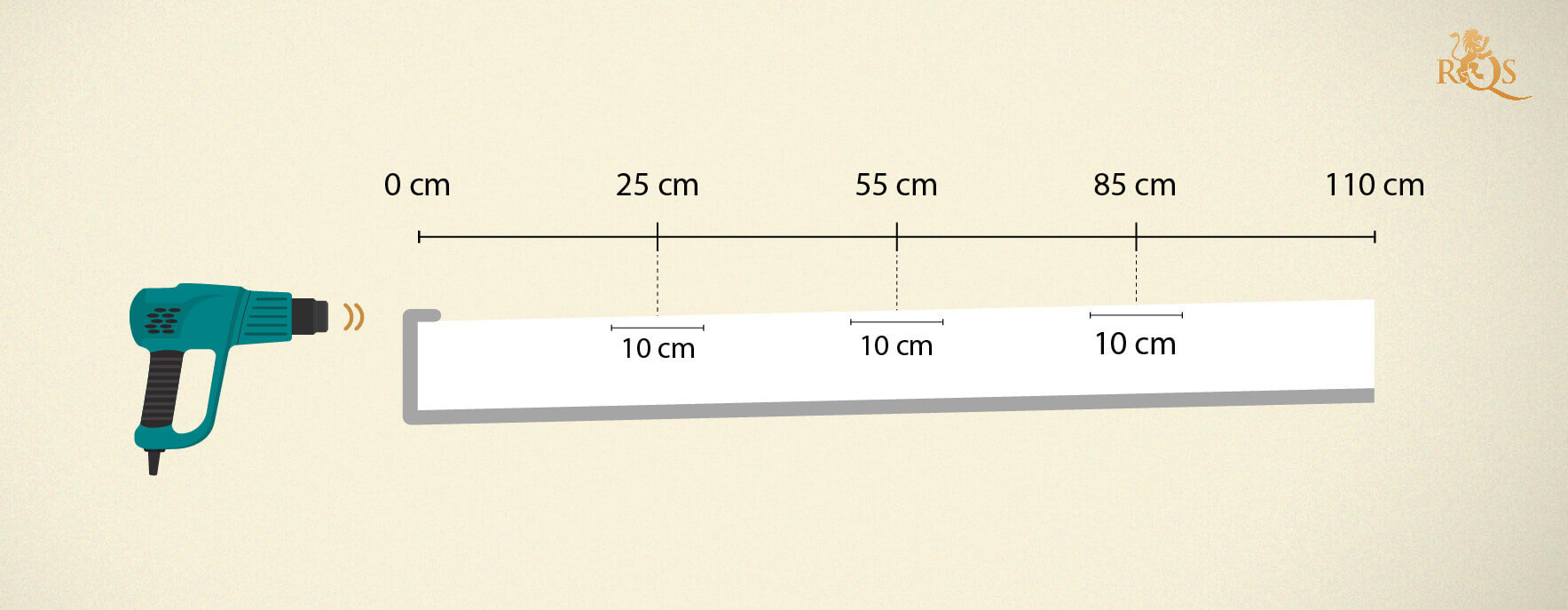
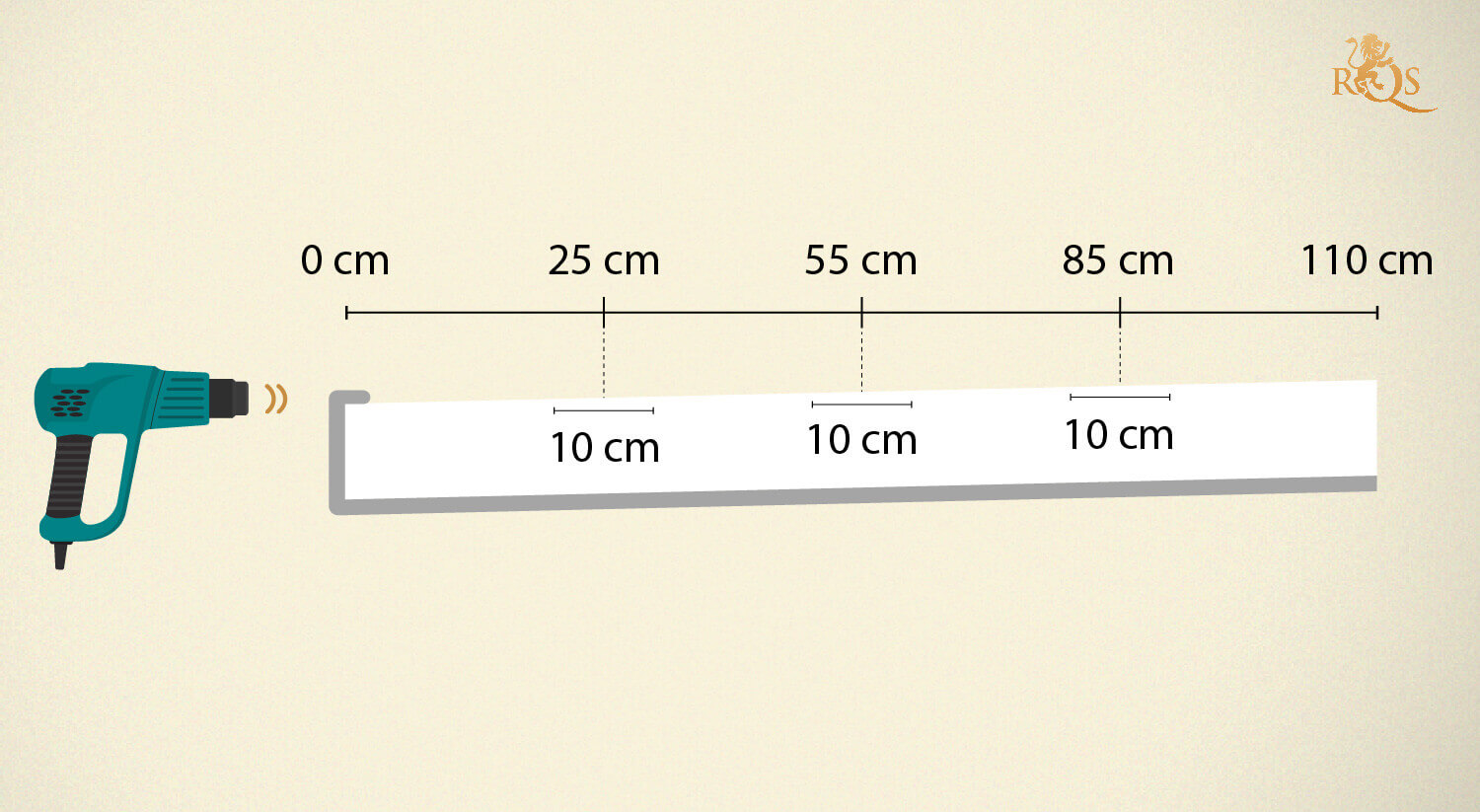
Step 3: Create your reservoir
You’ll need around 0.1 gallons per plant (0.2 gallons in total for this setup). However, it’ll help to use a bigger tote so you can easily make the following modifications. Grab your 10-gallon plastic tote. Depending on the height of your frame, you may need to elevate it off the ground so that it reaches the lower end of your channel. Choose one side of your tote and use a Stanley knife or a jigsaw to cut out a rectanglar hole big enough for the end of your channel to slot into, without any excess gaps for light to penetrate through. Create this hole close to the lip of your tote, well above the water line. Insert the end of your channel into this hole.
Next, use a big enough drill bit to create an additional hole close to the lip of the tote that fits the diameter of your pump hose. Thread your pump hose through this hole. Finally, make another hole next to this one, with a big enough diameter to thread your airstone hose pipe through.


Step 4: Establish flow
With your holes in place and reservoir ready for action, it’s time to establish some flow! First, use your drill to create another hole in your growing channel. Place this hole 2 inches from the upper end of your growing channel, between the end and the first net cup. Then, insert the end of your pump hose into the channel.
Place your pump and airstone into the reservoir and connect their respective pipes. Fill your reservoir with 0.2 gallons of nutrient solution and power up the system. Place the lid onto your tote to prevent light from fueling algal growth. Now, you’ll hear the pleasant trickling sound of water entering the top of the channel, and flowing back down into your reservoir.
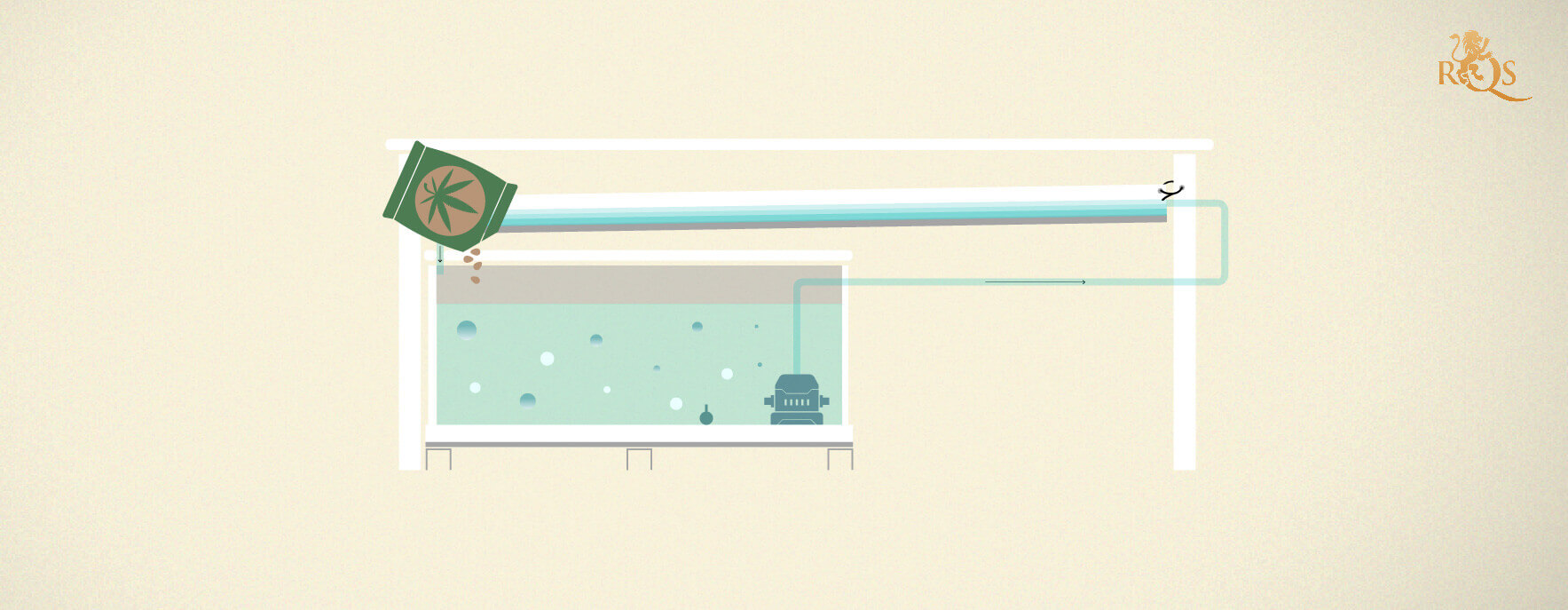

Step 5: Watch your plants grow!
After establishing seedlings, transplant them into their net pots and fill in any gaps with clay pebbles for structural support. Power up your lights (if growing indoors) and prepare to monitor pH to keep your plants happy and thriving!
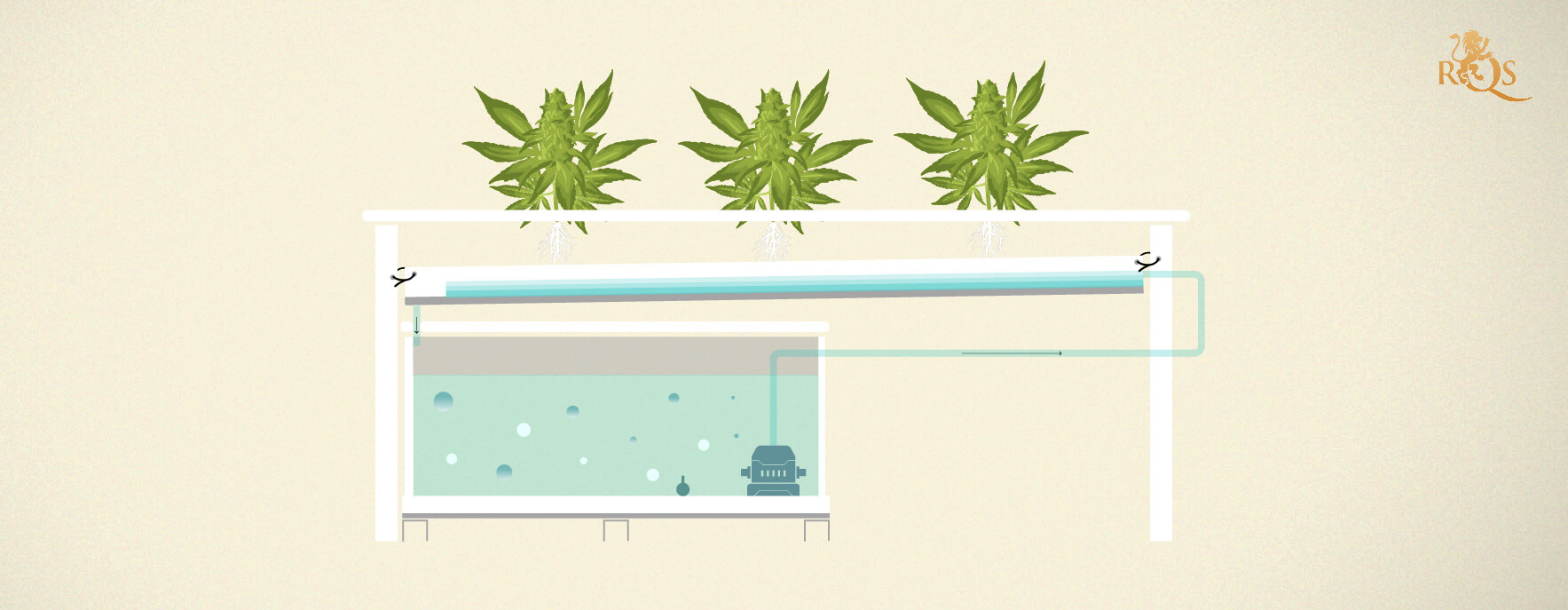

Why Is NFT Used Mostly In Hydroponic Systems?
Hydroponic cannabis growers have the luxury of choosing from six primary techniques. So, why do so many people opt for NFT above all of the others?
Firstly, NFT systems are highly flexible and modular; growers have the freedom to stack them vertically to make them suitable and productive in enclosed spaces. The water and nutrient efficiency of this method also helps to minimise waste and reduce costs over time. Perhaps most importantly, NFT systems allow plants to grow rapidly, resulting in quick turnovers that enhance stealth when growing at home, and bolstered profit margins in commercial settings.
Benefits of Nutrient Film Technique
NFT technique holds a prestigious status in the world of hydroponics. Although more sophisticated than more basic hydro setups, the effort it takes to establish an NFT system pays off handsomely when it comes to results. Continue reading to discover the key benefits of nutrient film technique hydroponic systems, and why you should consider growing cannabis this way.
NFT Systems Produce Bigger Yields
Although they take up little space when stacked vertically, NFT systems are capable of churning out mighty yields. When managed properly, they have the potential to outperform other hydroponic techniques and setups that utilise soil as a growing medium. Nutrient film technique manages to achieve such attractive outcomes for the following reasons:
- Oxygenation: Cannabis roots are exposed to a constant supply of oxygen that helps to promote healthy root growth, making these networks more receptive to nutrients.
- Enhanced nutrient uptake: Nutrients are delivered in water-soluble ionic forms, which allows them to diffuse directly into plant roots. In this scenario, cannabis plants don’t have to “work” for their nutrients through cation exchange and microbial symbiosis.
- Excellent root development: The open space and shallow current within NFT growing channels give cannabis roots plenty of room to grow and develop freely. Without the impediments of compacted soil, they quickly develop plenty of root hairs to work to intercept passing nutrients.
NFT Systems Are Highly Versatile
Nutrient film technique systems have received recognition for their impressive versatility, even from hardline soil purists. Much like growing in soil indoors, NFT systems can adapt to the space available. Moreover, growers aren’t limited to growing cannabis alone. The net pots used to hold cannabis plants can also house a variety of edible crops that thrive in a similar pH range and benefit from the same nutrient solution. Although it means less of a cannabis yield, growers can insert lettuce, spinach, and even strawberries into their system alongside their main crop to add a touch of self-sufficiency to their setup.
You’ll Have An Easier Time Cleaning Nutrient Film Technique Setups
Hydroponics systems have a long list of benefits, but they also require maintenance. Breaking down and scrubbing a system clean can become quite a chore. Thankfully, NFT systems are much easier than other hydroponic setups when it comes to scrubbing things down. Several factors make NFT systems easy to clean, including:
- Simple design: NFT systems feature simple designs with few components. Even when scaled up, these setups don’t feature complex pieces of kit, making them easier to take apart and scrub clean.
- Innate flow: NFT growing channels are made to facilitate the flow of a nutrient solution. Their gravity-friendly angle and smooth surfaces mean that debris accumulates slowly, making cleaning a less frequent task.
- Linear channels: NFT growing channels don’t feature bends, crevices, nooks, or crannies. This enables growers to scrub them clean without having to fully take them apart.
You Can Easily Observe Root Health in NFT Systems
It’s easy to overlook roots, especially when growing in soil. While luscious fan leaves and resinous buds tend to receive most of our attention, cannabis roots humbly work hard out of sight to keep plants alive and thriving. Cultivators pay special attention to different parts of plant anatomy during the growing cycle to check for pests, disease, and nutritional deficiencies—NFT systems allow you to apply this same level of inspection to roots. When inspecting roots, you’re looking for signs of health, such as a white or light brown appearance, a firm texture, little to no wilting, and no rotten smells.

Nutrient Film Technique for Commercial Production
Nutrient film technique is a popular way to raise hydroponic plants at home and in the garden. However, this method has also risen to prominence in commercial settings as a rapid and reliable method. NFT systems are capable of producing consistent results, with fewer pest and nutrient issues, and reduced inputs. Check out the key benefits of NFT hydroponics:
- Reduced water costs: Because hydroponics replace soil with water as a growing medium, it makes sense at face value that these systems use far more water. However, hydroponic systems use as much as 10 times less water[1] than soil-based setups. Because NFT uses a small trickle of water to nourish plants, they’re capable of using even less water when growing a small number of plants.
- Easier pest and disease scouting: The symptoms of pests and diseases are relatively visible on the aerial structures of cannabis plants. However, NFT systems allow growers to constantly monitor bare roots. Frequent checks allow cultivators to get a handle on certain pests and pathologies before they gain a foothold.
- Highly scalable: NFT systems allow commercial growers to start small and quickly expand. After mastering NFT at a small scale, they can easily build upon these systems in a modular fashion, adding a larger reservoir, pumps, and growing channels as and when needed.
- Fewer nutrient deficiencies: Plants in NFT systems are constantly exposed to an accurately formulated suite of nutrients—this liquid provides them with all of the minerals they need to fulfill vital physiological functions. Nutritional deficiencies are extremely rare in NFT systems compared to soil, where things can quickly go awry due to the number of variables at play.
Nutrient Film Technique Disadvantages
As you can see, nutrient film technique hydroponics systems boast a battery of benefits. However, like every other method of growing cannabis, it does come with a few downsides. These systems are often intimidating for beginner growers. They also take electricity to run, and they’re not immune to blockages. Find out more about the disadvantages of NFT systems below.
NFT Isn’t Beginner Friendly
As far as different hydroponics systems go, NFT setups aren’t the simplest. Beginner growers looking to venture into the world of hydroponics are better off developing their green fingers with easier options before attempting to assemble an NFT system and grow healthy plants in one. Many novices choose to cut their teeth on deep water culture systems (DWC), whereas others find success using the Kratky method—a technique that requires no pump or airstone.
Cannabis Roots Can Block NFT Channels
The narrow structure of NFT growing channels makes them susceptible to blockages caused by cannabis roots. Left unchecked, the large taproots of cannabis plants can quickly obstruct the flow of nutrients, causing potential blockages and leaks. Growers need to remain vigilant of this occurrence, especially when growing genetics that tend to produce big plants. To prevent root blockages, you should regularly prune your roots when they start to cause issues with the flow of the nutrient solution.
Nutrient Film Technique Setups are Active Systems
When it comes to minimalism, other growing techniques require a lot less energy than NFT systems. They need energy to run the pump and airstone, as well as lights if you're growing indoors. If closed-loop systems and sustainability rank high on your list of priorities, you’ll find other methods that are more compatible with your goals.
NFT Systems are Sensitive to Pump Failures
Because NFT systems rely on electricity to function, things can quickly go south during a power outage or pump malfunction. As soon as the pump goes, plants are immediately deprived of nutrients and water, and the film coating their roots will quickly dry up. This isn’t a big deal if you attend your plants every day, but can quickly spell disaster for more hands-off growers than run automated setups.
You Know the Benefits of NFT Systems—Now Learn How to Build One
And just like that, you seriously upgraded your knowledge of cannabis cultivation. Not only are you aware of how nutrient film technique hydroponic systems work, but you’re acquainted with their long list of attractive benefits. However, you won’t approach this growing technique with rose-tinted glasses; you also know about some of the drawbacks. So, why not put all of this new-found information to good use? Take the theoretical and make it practical! Find out how to build your own DIY nutrient film techniques to reduce your water use and grow plants that will rapidly develop before your very eyes.
- Hydroponics: A Better Way to Grow Food (U.S. National Park Service) https://www.nps.gov


























